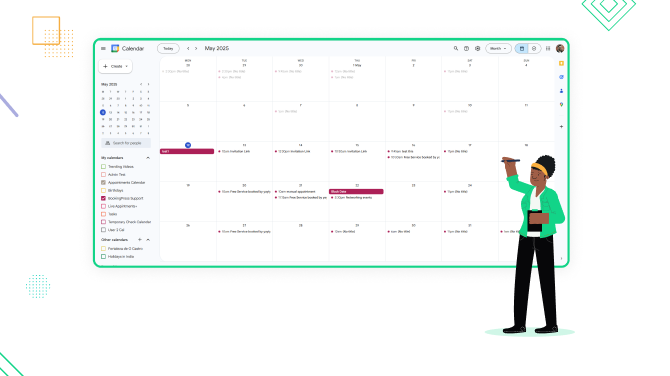8 Steps to Write a Successful Massage Therapy Business Plan

Got a passion for healing with massage therapy? That can surely convert into building your own massage therapy business.
But before you trade in lotion bottles for building permits, there’s one crucial step: the business plan. This roadmap to your future spa idea lays out your vision, strategy, and – most importantly – financials. Yes, it’s a boring and meticulous yet very needed job!
Decide what type of salon business you want to run

Before you grab your pen (or laptop), think about the foundation of your plan: what kind of business do you envision? Cozy home studio (where you are a boss) or a multi-therapist salon?
Your decision impacts your legal structure: think sole proprietorship, LLC, or corporation in the US, or sole trader, partnership, or limited company in Europe. The thing is that each comes with different tax implications and liability protections, so you have to make up your mind first, do your research, and pick the one that suits your idea.
Choose your business plan writing path

The first thing to understand: you should not necessarily write that plan yourself!
Now, about writing the actual plan, we know about three main paths anyone can start with:
Using a business plan template
Online business plan templates offer a structured approach for budget-conscious people.
Pros: affordability, easy-to-follow formats, and helpful prompts.
Cons: limited customization, potential information gaps, and the risk of a generic plan lacking your context, plus, your possible inability to assess those gaps.
Connecting a private consultant
Expert guidance can be the only way for some fresh business owners, because of the lack of time or even fear of making a mistake. A paid consultant can tailor a plan to your specific needs, offering industry insights and market analysis. Just pick up their brain!
Pros: personalized approach, valuable expertise, and potential time-saving benefits.
Cons: significant cost, relying on the consultant’s understanding of your vision, and potentially limited ownership over the final plan.
Consulting organizations
Many government agencies and business development centers offer free or low-cost resources, including workshops and even plan-writing guidance. Some examples include the SBA, SCORE, MBDA, and some others (search your local area).
Pros: affordability, access to local market information, and potential networking opportunities.
Cons: standardized advice, less hands-on support, and the time commitment of attending workshops.
Which path is right for you? To answer that question, rely on your budget, comfort level, and need for personalized guidance. You can always update your plan, even if it was written by someone else.
Create your business concept and vision (‘executive summary’)

Every business plan starts with a so-called ‘executive summary’, which is like ‘objectives’ in a lesson plan if we use the school terminology.
It might seem like a thing you’d want to skip, but we encourage you to do this ‘homework’ because understanding goals helps you achieve them. The difference between an executive summary and the actual company description is that the first is rather brief.
So what should an executive summary of a business plan include?
1. The goals of your massage business.
Here are a few questions to help you shape them:
- What motivates you to become a massage therapist?
- What unique skills or experiences do you have that differentiate you from other massage therapists?
- What type of massage business do you envision?
- Who is your ideal client?
- What services will you offer?
- What pricing strategy will you implement?
- What are your long-term business goals?
- What are your startup costs?
- What is your desired income level?
- What financial tools and resources will you need?
2. Name your target market (for example, wellness enthusiasts, specific conditions, athletes, pregnant women, etc.)
3. Outline basic costs and financial details you are aware of.
Write a detailed company description

This should help you better understand the business concept you want to target. This can be a long piece, but here are some things to help you stay focused:
- Outline your core values.
- Describe your ideal client.
- Map out your service mix.
- Sketch your operational vision.
Get into detail where possible; be honest, and specific, and don’t forget to describe action steps.
Describe your market

You should understand really well the client you are going to serve; that can’t be done without a market analysis.
This includes researching the massage therapy industry, especially in your area, and analyzing its growth potential, trends, and regulatory environment.
As for your target market, try to identify their demographics, needs, motivations, and preferred massage modalities. Of course, don’t forget to study competitors – check out their services, pricing, strengths, and weaknesses.
Add such a section to your business plan as market trends – like wellness preferences, technology integration, and sustainability practices. Ask yourself – will they keep your offerings relevant and future-proof? This all is needed to cater to the right clients, identify exceptional service, and find your unique proposition.
Describe your management

Starting a massage salon, the organizational structure will initially be lean yet adaptable. You will need to describe the management team and their capabilities.
Are you going to wear multiple hats, handling client services, marketing, administrative tasks, and financial management? Or do you want to hire experts? Write all these visions down.
Think about where you can outsource: collaborate with a freelance accountant for bookkeeping or outsourcing marketing initiatives.
Your massage therapy business plan should contain details about how you can grow. For example, you can write things like “As my client base grows, I may expand by hiring additional therapists”, or shape it to your vision better.
Define and describe the skills and certifications you are looking for in your staff, then establish a clear structure outlining their roles and responsibilities, including massage modalities offered, scheduling appointments, maintaining client records, and more.
Read also: 10 Best Scheduling Software for Small Business
Outline your marketing plan

Marketing your massage salon services is a long story, but you can start with outlining the basics, such as:
- Digital marketing: Your massage therapy website (booking, information), social media email marketing (offers, newsletters), online directories (listings).
- Content marketing: Blog posts (expertise, tips), social media content (engaging, informative), collaborations with influencers.
- Promotional activities: Special offers, discounts for referrals, loyalty programs, and partnerships with local businesses.
- Pricing strategy: Outline your pricing structure for different massage types and packages.
- Appointment scheduling: Describe your salon booking system, cancellation policy, and any incentives for booking in advance.
- Client retention: How will you encourage repeat business?
Describe financial details

In this section, you need to try to create a data-driven roadmap for your finances, showcasing viability and attracting potential investors. Here are 3 key elements you can concentrate on in your massage therapy business plan:
Revenue projections
Consider the average massage cost, client frequency, and expected market competition.
Also, differentiate between individual massages, package sales, additional services like aromatherapy, and product sales. Include projections for peak and off-seasons to understand cash flow variations.
Operational expenses
Start with operational costs that usually include rent, utilities, equipment, supplies, insurance, marketing, professional development, and employee salaries. Fixed costs remain constant (rent), while variable costs fluctuate with revenue (supplies). Account for the wear and tear of assets like massage tables and equipment over their useful life.
Profitability
Aim for a sustainable margin that covers costs and allows for reinvestment. Project your cash flow, including operational expenses, debt payments, and potential emergencies.
Bonus Checklist for a Massage Therapy Business Plan
Additionally, here is a quick checklist of things you need to write a business plan for your massage therapy or salon business:
- Industry reports and market analysis.
- Competitor analysis.
- Demographic data for your target market.
- Laptop or desktop computer.
- Word processing software (e.g., Microsoft Word, Google Docs, or similar).
- Spreadsheet software (e.g., Microsoft Excel, Google Sheets) for financial projections and budgeting.
- Business plan templates or guides.
- SWOT analysis (Strengths, Weaknesses, Opportunities, Threats).
- Licenses and permits.
- Certifications for you and your staff.
- Lease agreements or property documents.
- Insurance policies.
- Resumes of key personnel.
Related articles:

Get BookingPress Premium
50+ Premium Addons
20+ Payment Gateways
Plan starts at just $79
Get Premium Now






